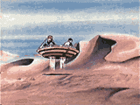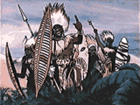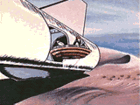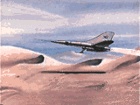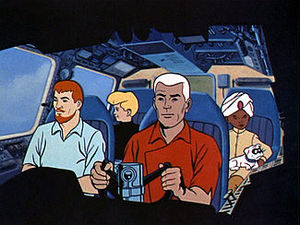- Jonny Quest (TV series)
-
Jonny Quest 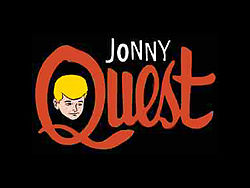
Original Jonny Quest title card from 1964Format Animated/Science fiction/Adventure Created by Doug Wildey Directed by William Hanna
Joseph BarberaStarring 1964–65:
Tim Matheson as Jonny Quest
Mike Road as Roger "Race" Bannon
Danny Bravo as Hadji
John Stephenson as Dr. Quest (5 episodes)
Don Messick as Dr. Quest and Bandit
1986–87:
Scott Menville as Jonny Quest
Granville Van Dusen as "Race" Bannon
Rob Paulsen as Hadji
Don Messick as Dr. Quest and BanditTheme music composer Hoyt Curtin Country of origin United States No. of seasons 2 No. of episodes 26 Production Producer(s) William Hanna
Joseph BarberaRunning time 25 minutes (1964-65)
22 minutes (1986–87)Production company(s) Hanna-Barbera Distributor Warner Bros. Television Broadcast Original channel ABC (1964–65)
Syndication (1986–87)Original run September 18, 1964 – March 11, 1965 Jonny Quest – often casually referred to as The Adventures of Jonny Quest – is an American science fiction/adventure animated television series about a boy who accompanies his father on extraordinary adventures. It was produced by Hanna-Barbera Productions for Screen Gems, and created and designed by comic book artist Doug Wildey.
Inspired by radio serials and comics in the action-adventure genre, it featured more realistic art, characters, and stories than Hanna-Barbera's previous cartoon programs. It was the first of several Hanna-Barbera action-based adventure shows – which would later include Space Ghost, The Herculoids, and Birdman and the Galaxy Trio – and ran on ABC in prime time on early Friday nights for one season in 1964–65.
After spending two decades in reruns, during which time it appeared on all 3 major US television networks of the time, new episodes were produced for syndication in 1986. Two telefilms, a comic book series, and a more modern revival series, The Real Adventures of Jonny Quest, were produced in the 1990s. Reruns of Johnny Quest can be seen on Cartoon Network's classic cartoon channel Boomerang.
Contents
Inspiration
Comic book artist Doug Wildey, after having worked on Cambria Productions' 1962 animated television series Space Angel,[1] found work at the Hanna-Barbera studio, which asked him to design a series starring the radio drama adventure character Jack Armstrong, the All-American Boy.[2]
Wildey wrote and drew a presentation, using such magazines as Popular Science, Popular Mechanics, and Science Digest "to project what would be happening 10 years hence", and devising or fancifully updating such devices as a "snowskimmer" and hydrofoils. When Hanna-Barbera could not or would not obtain the rights to Jack Armstrong, the studio had Wildey rework the concept. Wildey said he "went home and wrote Jonny Quest that night — which was not that tough." For inspiration he drew on Jackie Cooper and Frankie Darrow movies, Milton Caniff's comic strip Terry and the Pirates, and, at the behest of Hanna-Barbera, the James Bond movie Dr. No. As Wildey described in 1986, producer Joe Barbera had seen that first film about the English superspy "and wanted to get in stuff like [Bond's code-number] '007' — numbers. Which we included, by the way, in the first [episode of] Jonny Quest. It was called 'Jonny Quest File 037' or something. We dropped that later; it didn't work. But that was his father's code name as he worked for the government as a scientist and that kind of thing.[2] Hanna-Barbera refused to give him a "created by" credit, Wildey said, and he and studio "finally arrived on 'Based on an idea created by', and that was my credit."[2]
The Saturday-morning TV animated series Jonny Quest debuted on ABC on September 18, 1964. As comics historian Daniel Herman wrote,
Wildey's designs on Jonny Quest gave a cartoon a distinctive look, with its heavy blacks [i.e. shading and shadow] and its Caniff-inspired characters. . . . The show was an action/adventure story involving the feature's namesake, an 11-year-old boy. The cast of characters included Jonny's kid sidekick, named Hadji, Jonny's globetrotting scientist dad . . . and the group's handsome bodyguard, secret agent Race Bannon, who looks as if he stepped out of the pages of [Caniff's comic strip] Steve Canyon. . . . The look of Jonny Quest was unlike any other cartoon television show of the time, with its colorful backgrounds, and its focus on the characters with their jet packs, hydrofoils, and lasers. Wildey would work on other animation projects, but it was with his work on Jonny Quest that he reached his widest audience, bringing a comic book sense of design and style to television cartoons.[3]
Wildey did not design the more cartoonishly drawn, pet bulldog, Bandit, which was designed by animator Dick Bickenbach.[2]
Although they do not appear in any episode, scenes from the Jack Armstrong test film were incorporated into the Jonny Quest closing credits.[citation needed] They are the scenes of Jack Armstrong and Billy Fairfield escaping from African warriors by hovercraft. The test sequence and a number of drawings and storyboards by Wildey were used to sell the series to ABC and sponsors.[citation needed]
The show's working titles were The Saga of Chip Baloo, which Wildey said "wasn't really serious, but that was it for the beginning",[2] and Quest File 037.[4][5][6] The name Quest was selected from a phone book, for its adventurous implications.[2][7]
Characters
- Jonathan "Jonny" Quest is an 11-year-old American boy who lost his mother at an early age. Though unenthusiastic in his schooling, he is adventurous and generally athletic, with a proficiency in judo, scuba diving, and the handling of firearms. He takes on responsibility willingly, attending to his studies, and treating adults with respect. His voice was provided by actor Tim Matheson.
- Dr. Benton C. Quest is Jonny's father and a US government scientist, considered to be "one of the three top scientists in the world," with interests and technical know-how spanning many fields. Raising Jonny and Hadji as a single father, he is conscientious and decent, though willing and able to take violent decisive action when necessary for survival or defense. Benton Quest was voiced by John Stephenson for five episodes, and by the late Don Messick for the remainder of the series.
- Roger T. "Race" Bannon is a special agent / bodyguard / pilot from Intelligence One. Governmental fears that Jonny could "fall into the wrong hands" resulted in Bannon's assignment to guard and tutor him.[8] Race was born in Wilmette, Illinois, to John and Sarah Bannon.[9] He is an expert in judo, having a third-degree black belt as well as the ability to defeat noted experts in various martial arts, including sumo wrestlers. The character was voiced by Mike Road, with his design modeled on actor Jeff Chandler.[10] The name is a combination of Race Dunhill and Stretch Bannon from an earlier Doug Wildey comic strip.[2] The surname Bannon is Irish (from 'O'Banain') meaning "white".[11][12]
- Hadji is a streetwise, 11-year-old Calcutta orphan, who becomes the adopted son of Dr. Benton Quest.[13] Rarely depicted without his bejeweled turban and Nehru jacket, he is proficient in judo, which he learned from an American Marine. The seventh son of a seventh son, Hadji seems to possess mystical powers (including snake charming, levitation, magic, and hypnotism) which may or may not be attributed to parlor trickery. The Quests meet Hadji while Dr. Quest is lecturing at Calcutta University; he saves Dr. Quest's life (by blocking a thrown knife intended for the doctor with a basket lid) and is subsequently adopted into the Quest family.[14] Though slightly more circumspect than Jonny, he can reliably be talked into participating in most any adventure by his adoptive brother. He is voiced by Danny Bravo. In the sequel series The Real Adventures of Jonny Quest, Hadji is revealed to be an Indian prince, and is given the last name Singh.
- Bandit is the name of Jonny's pet, a small white bulldog. He has been so named because his eyes have a black, mask-like coloration around them. This coloration is occasionally instrumental in foiling antagonists. Though unable to speak, in the manner of some other Hanna-Barbera cartoon dogs, he seems uncannily able to understand human speech and is capable of complex facial expressions. Don Messick provided Bandit's vocal effects, which were combined with an archived clip of an actual dog barking.[citation needed] Creator Doug Wildey wanted to have a monkey as Jonny's pet, but he was overruled by Hanna-Barbera.[2]
The Quests have a home compound in the Florida Keys (on the island of Palm Key), but their adventures take them all over the world. The Quest team travels the globe studying scientific mysteries, which generally end up being explained as the work of various bad guys. Such pursuits get them into scrapes with foes that range from espionage robots and electrical monsters to Egyptian mummies and pterosaurs. Although most menaces appeared in only one episode each, one recurring nemesis is known as Dr. Zin, an Asian criminal mastermind.[15] With yellow skin and a diabolical laugh, Zin was an example of the Yellow Peril villains common in Cold War-era fiction.[15][16] The voices of Dr. Zin and other assorted characters were done by Vic Perrin. Race's mysterious old flame, Jade (voiced by Cathy Lewis), appears in two episodes, as do the characters of Corbin (an Intelligence One agent) and the Professor (a scientist colleague of Dr. Quest's). The 1993 made-for-TV feature Jonny's Golden Quest included in its plotline the concept that Race and Jade had been briefly married years earlier, but it also depicted Race and Hadji in place with the family at Mrs. Quest's death, in direct contradiction to explicit statements in the original series.
Animation technique
As the first major studio devoted to television animation (with previous studios, such as Warner Bros. and Disney, devoted to animation for theatrical release), Hanna-Barbera developed the technique of limited animation in order to cut corners and meet the tighter scheduling and budgetary demands of television. As opposed to full animation, this means that characters generally move from side to side with a sliding background behind them and are drawn mostly in static form, with only the moving parts (like running legs, shifting eyes, or talking mouths) being re-drawn from frame to frame on a separate layer.
This was particularly true of Jonny Quest. The series' visual style was unusual for its time, combining a fairly realistic depiction of human figures and objects with the limited animation technique (although not so limited as that of Hanna-Barbera's contemporaneous daytime cartoons). The series made heavy use of rich music scores, off-screen impacts with sound effects, reaction shots, cycling animations, cutaways, scene-to-scene dissolves, and abbreviated dialogue to move the story forward, without requiring extensive original animation of figures. For example, objects would often reverse direction off-screen, eliminating the need to show the turn,[17] or a running character would enter the frame sliding to a stop, allowing a single drawn figure to be used.[18]
Network run and Saturday morning reruns
Jonny Quest first aired on September 18, 1964 on the ABC network, in prime time, and was an almost instant success, both critically and ratings-wise. It was canceled after one season, not because of poor ratings, but because each episode of the show went over budget.[citation needed] Like the original Star Trek television series, this series would be a big money-maker in syndication, but this avenue to profits was not as well-known when the show was canceled in 1965. Reruns of the show were broadcast on various networks’ Saturday morning lineups beginning in 1967.
Censorship and Controversy
Jonny Quest became a target of parental watchdog group Action for Children's Television (ACT) for its multiple onscreen deaths, murder attempts, use of firearms and deadly weapons, depictions of monsters, and tense moments.[citation needed] Reruns were taken off the air in 1972, but returned to Saturday morning, in edited form,[citation needed] sporadically afterward.[citation needed].
Music
The percussion-heavy big band jazz theme music for the 1960s series and each episode's score were all composed by Hoyt Curtin. In a 1999 interview, he stated that the jazz band for the series consisted of 4 trumpets, 6 trombones, 5 woodwind doublers, and a 5-man rhythm section.[19] Alvin Stoller or Frankie Capp usually played drums.[citation needed] While a string section comes in at moments of tension or pizzicato for comic relief, the score is primarily driven by a big brass sound. Curtin stated that the band took about an hour to record the main theme. It contained a trombone solo performed by jazz veteran Frank Rosolino, and a complex riff in which the trombone players were physically unable to keep up with the rapidly changing slide positions needed.[19] Cues in the series were generally recorded in one take, done by a regular group of union session players who could "read like demons". The cues were, of course, later recycled for other Hanna-Barbera series (The Herculoids, The Fantastic Four, Birdman and the Galaxy Trio etc.).
For the later animated series, the music was adapted for orchestra and added major dramatic and intriguing tones.
The original version of this theme song became available on the CD entitled Television's Greatest Hits, Vol.2: From the 50s and 60s, produced in 1990, and on that recording the composition is called merely Jonny Quest.
Merchandise
A simple substitution code ring was offered as a promotion by PF Flyers. The ring featured a movable code wheel, magnifying lens, signal flasher and a secret compartment. The code was implemented by a rotating circular inner code dial marked "ABCDEFGHIJKLMNOPQRSTUVWXYZ" and a fixed outer code marked "WEARPFSLQMYBUHXVCZNDKIOTGJ", i.e. "Wear PFs".
Home video
Various episodes of the classic series have been released on VHS over the years.
On May 11, 2004, Warner Home Video released Jonny Quest: The Complete First Season on DVD in Region 1, which features all 26 episodes of the original series,[20] although some have been edited for content and contain incorrect closing credits.[citation needed]
References
- ^ Herman, Daniel. Silver Age: The Second Generation of Comic Artists (Hermes Press, Neshannock Township, Pennsylvania, 2004) p. 195. Trade paperback ISBN 978-1-9325-6364-1
- ^ a b c d e f g h Olbrich, David W. "Doug Wildey, an interview with the creator of Jonny Quest", Amazing Heroes #95 (ISSN 0745-6506), May 15, 1986, p. 34 WebCitation archive
- ^ Herman, pp. 195-196
- ^ Castleman, Harry, and Walter J. Podrazik, Harry and Wally's Favorite TV Shows, Prentice Hall Press, 1989
- ^ Brooks, Tim and Earle Marsh, The Complete Directory to Prime Time Network and Cable TV Shows, 1946-Present, Ballantine Books, 1995 (sixth ed.)
- ^ TV Guide Guide to TV (Barnes and Noble Books, 2004)
- ^ Barbera, Joseph (1994). My Life in "Toons": From Flatbush to Bedrock in Under a Century. Atlanta, GA: Turner Publishing Company. p. 152. ISBN 1-57036-042-1.
- ^ "The Mystery of the Lizard Men," Jonny Quest, 18 September 1964
- ^ "Double Danger," Jonny Quest, 13 November 1964
- ^ Quest documentary, part 11 on YouTube
- ^ http://www.xs4all.nl/~bultman/BB/surnames.html
- ^ http://www.irishsurnames.com/cgi-bin/gallery.pl?name=bannon&capname=Bannon&letter=b
- ^ Boucher, Geoff (2009), “Hero Complex: In Search of Jonny Quest”, Los Angeles Times, February 13, 2009
- ^ "Calcutta Adventure". Jonny Quest. 30 October 1964. No. seven, season one.
- ^ a b Saturday morning fever, Timothy Burke, Kevin Burke pp. 113-116
- ^ The supervillain book: the evil side of comics and Hollywood, Gina Renée Misiroglu, Michael Eury, Visible Ink Press, 2006
- ^ Quest documentary, part 5 on YouTube
- ^ Quest documentary, part 6 on YouTube
- ^ a b Quest documentary, part 16 on YouTube
- ^ Jonny Quest at TVShowsOnDVD.com
Lists
Jonny Quest Television series Jonny Quest (episodes) · The New Adventures of Jonny Quest · The Real Adventures of Jonny Quest (episodes)Television films Other Jonny Quest: Cover-Up at RoswellFirst-run animated series Dastardly and Muttley in Their Flying Machines (1969–1971) • The Perils of Penelope Pitstop (1969–1971) • Scooby-Doo, Where Are You! (1969–1972, 1974–1976) • Sabrina the Teenage Witch • Groovie Goolies • Josie and the Pussycats (1970–1971) • Harlem Globetrotters (1970–1971) • Help!... It's the Hair Bear Bunch! (1971–1974) • The Pebbles and Bamm-Bamm Show (1969–1972) • Archie's TV Funnies (1971–1973) • The Flintstone Comedy Hour • Bailey's Comets • The Amazing Chan and the Chan Clan (1972) • The New Scooby-Doo Movies (1972–1974) • My Favorite Martians • Jeannie (1973–1975) • Speed Buggy • Fat Albert and the Cosby Kids (1972–1984) • Partridge Family 2200 A.D. (1974–1975) • Valley of the Dinosaurs (1974–1976) • The U.S. of Archie (1974–1976) • Clue Club (1976–1977) • Tarzan, Lord of the Jungle • The New Adventures of Batman • What's New Mr. Magoo? • The Batman/Tarzan Adventure Hour • The Robonic Stooges • The All-New Popeye Hour (1978–1983) • Tarzan and the Super 7 • The New Adventures of Mighty Mouse and Heckle & JeckleFirst-run live-action series Captain Kangaroo (1955–1984) • In the News • You Are There • CBS Children's Film Festival • Shazam! (1974–1977) • The Harlem Globetrotters Popcorn Machine • The Hudson Brothers Razzle Dazzle Show • The Secrets of Isis • Far Out Space Nuts • The Ghost Busters • Ark II • Way Out Games • The Skatebirds (1977–1978) • Space Academy (1977–1979) • Wacko • 30 Minutes • Jason of Star Command (1978–1981)Rebroadcasts The Jetsons • The Bugs Bunny/Road Runner Hour (1968–1971; 1975–1978; 1978–1985) • The Monkees (1969–1972) • Wacky Races (1968–1970) • The New Adventures of Superman • Jonny Quest • Sylvester and Tweety (1976–1977)Schedules 1969-70 • 1970-71 • 1971-72 • 1972-73 • 1973-74 • 1974-75 • 1975-76 • 1976-77 • 1977-78 • 1978-79 • 1979-80Related programming and topics First-run animated series The New Casper Cartoon Show (1963-1970) • The Smokey the Bear Show • The Cattanooga Cats Show (1969-1971) • Hot Wheels (1969-1971) • The Hardy Boys (1969-1971) • Skyhawks (1969-1971) • The Adventures of Gulliver (1968-1970) • Fantastic Voyage (1968-1970) • Will the Real Jerry Lewis Please Sit Down (1970-1972) • The Road Runner Show • The Funky Phantom (1971–1973) • The Jackson 5ive (1971–1973) • The Osmonds (1972-1974) • The ABC Saturday Superstar Movie (1972-1974) • The Brady Kids (1972–1974) • Kid Power (1972-1974) • Yogi's Gang (1973-1975) • Super Friends • Lassie's Rescue Rangers (1973-1975) • Goober and the Ghost Chasers (1973) • Mission: Magic! (1973-1974) • Hong Kong Phooey (1974-1976) • The New Adventures of Gilligan (1974-1977) • Devlin (1974-1976) • These Are the Days (1974-1976) • The Tom and Jerry Show (1975-1977) • The Great Grape Ape Show (1975-1976) • The Oddball Couple (1975-1977) • Jabberjaw (1976-1978) • The Scooby-Doo/Dynomutt Hour • The Mumbly Cartoon Show (1976-1977) • The All-New Super Friends Hour • Scooby's All-Star Laff-A-Lympics (The Scooby-Doo Show • Laff-A-Lympics • Captain Caveman and the Teen Angels) • Fangface (1978-1979) • Challenge of the Super Friends • The All-New Pink Panther Show (1978-1979) • The World's Greatest Super Friends • The Plastic Man Comedy/Adventure Show (Mighty Man and Yukk • Rickety Rocket) (1979-1981) • Spider-Woman (1979-1980) • Scooby-Doo and Scrappy-DooFirst-run live-action series American Bandstand (1957-1987) • Lancelot Link, Secret Chimp • Here Come the Double Deckers (1970–1972) • Lidsville (1971–1973) • Curiosity Shop • Korg: 70,000 B.C. • The Lost Saucer • Uncle Croc's Block (1975-1976) • The Krofft Supershow (1976-1978) • Junior Almost Anything Goes (1976-1978) • ABC Weekend Special (1977-1997)Rebroadcasts George of the Jungle (1967-1970) • Bewitched • Jonny Quest (1970–1972) • H.R. Pufnstuf • The Monkees (1972–1973) • Speed Buggy • Scooby-Doo, Where Are You!Schedules 1969-70 • 1970-71 • 1971-72 • 1972-73 • 1973-74 • 1974-75 • 1975-76 • 1976-77 • 1977-78 • 1978-79 • 1979-80Related programming and topics Children's programming on NBC in the 1970s First-run animated series Here Comes the Grump • The Pink Panther Show (1969–1978) • The Underdog Show • The Further Adventures of Dr. Dolittle • The Houndcats • The Roman Holidays • The Barkleys • Sealab 2020 • Around the World in 80 Days • Inch High, Private Eye • The Addams Family • Emergency +4 • Butch Cassidy and the Sundance Kids • Star Trek: The Animated Series (1973–1975) • Wheelie and the Chopper Bunch • The Secret Lives of Waldo Kitty • Return to the Planet of the Apes (1975–1976) • CB Bears • The Young Sentinels • The New Archie and Sabrina Hour (1977) • I Am the Greatest: The Adventures of Muhammad Ali • Baggy Pants and the Nitwits • Yogi's Space Race • The Godzilla Power Hour • Fantastic Four • Fabulous Funnies • The New Fred and Barney Show • Buford and the Galloping Ghost • Casper and the Angels • Fred and Barney Meet the Thing • The Super Globetrotters • The New Shmoo • The New Adventures of Flash Gordon (1979–1980)First-run live-action series H.R. Pufnstuf • The Banana Splits Adventure Hour • Barrier Reef • The Bugaloos (1970-1972) • Mr. Wizard • Runaround • Lidsville • Sigmund and the Sea Monsters • Go • Run, Joe, Run • Land of the Lost (1974–1977) • Westwind • McDuff, the Talking Dog • Monster Squad • Big John, Little John (1976–1977) • The Kids From C.A.P.E.R. • Muggsy • Thunder • Search and Rescue • The Red Hand Gang • The Krofft Superstar HourRebroadcasts Schedules Related programming and topics First-run animated series Casper and the Angels • Fred and Barney Meet the Thing • The Super Globetrotters • The New Shmoo • The New Adventures of Flash Gordon (1979–1980) • Fred and Barney Meet the Shmoo • Godzilla • The Flintstone Comedy Show • The Smurfs (1981–1990) • The Kid Super Power Hour with Shazam! • Spider-Man and His Amazing Friends (1981–1983) • Space Stars • The Flintstone Funnies • Shirt Tales • The Gary Coleman Show (1982–1983) • The Incredible Hulk • Alvin and the Chipmunks (1983–1991) • Mister T • Snorks (1984–1989) • Pink Panther and Sons • Kidd Video (1984–1987) • Disney's Adventures of the Gummi Bears (1985–1989) • It's Punky Brewster (1985–1987) • Kissyfur (1986–1987) • Foofur • Lazer Tag Academy • Fraggle Rock: The Animated Series (1987–1988) • ALF: The Animated Series (1987–1989) • The New Archies • ALF Tales • The Completely Mental Misadventures of Ed Grimley • Camp Candy (1989–1990) • Captain N: The Game Master (1989–1992) • The Karate Kid (1989–1990)First-run live-action series Rebroadcasts The Daffy Duck Show (The Daffy/Speedy Show) • Jonny Quest • The Jetsons • Dynomutt, Dog Wonder • Hong Kong Phooey • Batman and the Super 7 • Bullwinkle (1981–1982) • Thundarr the Barbarian • Fat Albert and the Cosby KidsSchedules Related topics Prime time animated television series in the United States ABC The Bugs Bunny Show (1960–1962) • Capitol Critters (1992) • Clerks: The Animated Series (2000) • The Critic (1994) • The Flintstones (1960–1966) • The Goode Family (2009) • The Jetsons (1962–1963) • Jonny Quest (1964–1965) • Matty's Funday Funnies (1959-1961) • Matty's Funnies with Beany and Cecil (1962) • Peanuts television specials (1965-present) • Top Cat (1961–1962)CBS The Alvin Show (1961-1962) • CBS Cartoon Theater (1956) • Creature Comforts (2007) • Family Dog (1993) • Fish Police (1992) • Garfield television specials (1982-1991) • The Gerald McBoing-Boing Show (1956-1957) • This Is America, Charlie Brown (1988–1990) • Wacky Races (1967-1970) • Where's Huddles? (1970)Fox Allen Gregory (2011-present) • American Dad! (2005–present) • Batman: The Animated Series (1992-1993) • Bob's Burgers (2011-present) • The Cleveland Show (2009–present) • The Critic (1995) • Family Guy (1999–2002; 2005–present) • Futurama (1999-2003) • King of the Hill (1997–2009) • Napoleon Dynamite (2012-) • The PJs (1999–2000) • The Simpsons (1989–present) • Sit Down, Shut Up (2009)NBC The Bullwinkle Show (1961-1963) • The Famous Adventures of Mr. Magoo (1964-1965) • Father of the Pride (2004) • God, the Devil and Bob (2000) • Jokebook (1982) • The Ruff & Reddy Show (1957-1960) • Sammy (2000) • Stressed Eric (1998)UPN WB Baby Blues (2000) • Freakazoid! (1996) • Invasion America (1998) • Mission Hill • (1999–2000) • The Oblongs (2001) • Pinky and the Brain (1995–1996, 1997) • The PJs (2000–2001)First-run syndication The Huckleberry Hound Show (1958-1962) • Tiny Toon Adventures (Prime Toons) (1990-1991) • Wait Till Your Father Gets Home (1972-1974)Hanna-Barbera characters Tom and Jerry The Flintstones Scooby-Doo The Jetsons George Jetson · Jane Jetson · Judy Jetson · Elroy Jetson · Astro · Rosie the Robot Maid · Mr. SpacelyYogi Bear and Huckleberry Hound Yogi Bear · Boo-Boo Bear · Ranger Smith · Cindy Bear · Snagglepuss · Yakky Doodle · Huckleberry Hound · Pixie and Dixie and Mr. Jinks · Hokey WolfQuick Draw McGraw The Smurfs Magilla Gorilla Peter Potamus Jonny Quest Space Ghost Wacky Races Top Cat Atom Ant and Secret Squirrel The Hanna-Barbera New Cartoon Series Grape Ape Grape Ape · Beegle BeagleOther Categories:- Animated sitcoms
- American Broadcasting Company network shows
- Television series by Sony Pictures Television
- Television series by Warner Bros. Television
- 1960s American animated television series
- First-run syndicated television programs in the United States
- 1964 television series debuts
- 1965 television series endings
- American science fiction television series
- Jonny Quest
Wikimedia Foundation. 2010.

